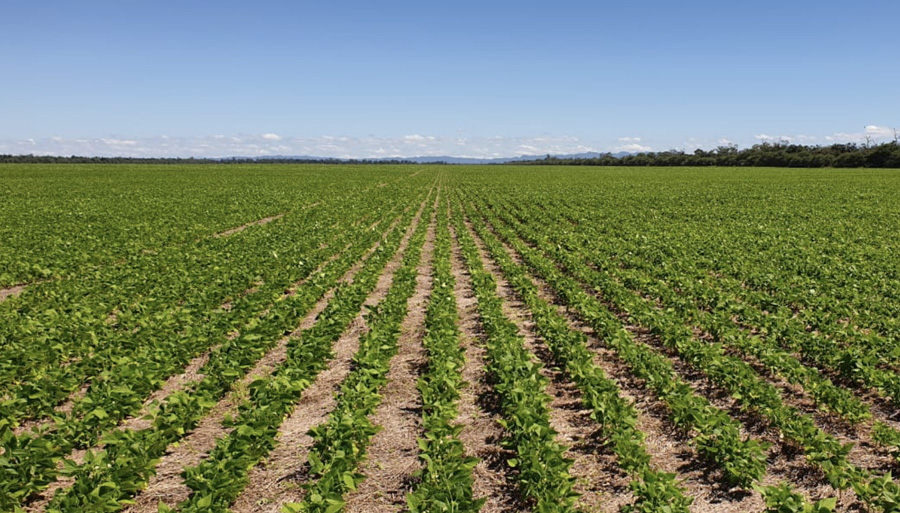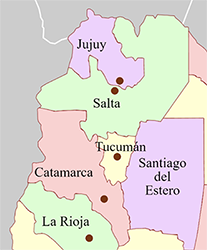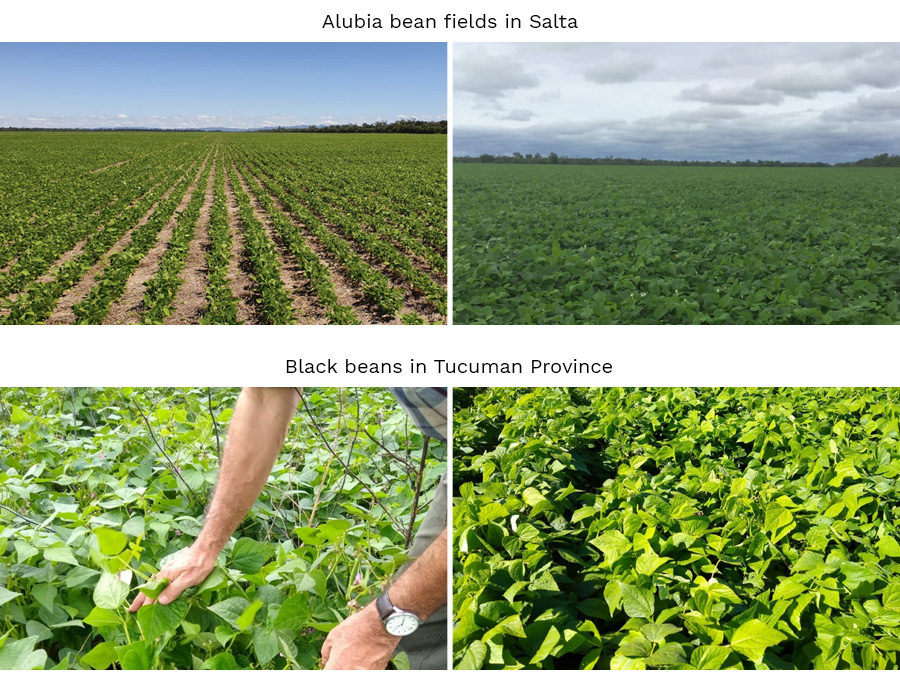September 4, 2019
Harvest dragged on into mid-August, well beyond the traditional window, due to weather delays at both planting and harvest.


Alubia bean fields in Salta. Photos courtesy of Sergio Raffaeli.
Argentina is a major dry bean exporter. Because its domestic consumption is nearly non-existent, it contributes practically all of its production (generally about 340,000 MT) to the global dry bean trade. Alubia and black beans comprise the bulk of its dry bean output, although it also produces smaller quantities of several other bean classes.
Dry beans are grown in two distinct regions in Argentina. Its prized alubia beans are grown mostly in the northwestern provinces of Salta and Jujuy. This year, the bean harvest there extended into mid-August, well beyond the typical harvest window, due to rain delays at both planting and harvest. Despite the late date, however, frost, which was a major concern, never did materialize, and the crop was spared its effects.
The bulk of Argentina’s black bean crop is grown farther south, in the provinces of Tucuman, Santiago del Estero, Catamarca and the southern part of Salta. The bean harvest there typically wraps up earlier than in the north, but here, too, harvest extended beyond the typical window, this time due to a dry spell in mid-February and rains that delayed the soybean harvest and pushed back the start of the dry bean harvest.
“This has been a long harvest season,” sums up Sergio Raffaeli, President of CLERA (Argentina’s Chamber of Pulses). “It started in early June, earlier than ever before in my memory, and didn’t wrap up till mid-August.”
Below, we take a closer look at Argentina’s 2019/20 bean crop by commercial class.

The major dry bean growing provinces are Jujuy, Salta, Tucuman, Catamarca and Santiago del Estero / Source: Wikipedia
In northern Salta, Argentina’s alubia bean crop went in the ground in three distinct and approximately equal phases. The first third of the crop was planted on time (from February 15thto the 25th) and benefitted from favorable weather throughout the growing season. This part of the crop had the best yields and the finest quality. The second third was seeded from early March through mid-March, and the final third was seeded from March 25thto April 10th. The latter two thirds were seeded late and although they were spared frost damage, the yields and quality of the beans were affected by harvest rains. The crop planted after March 25th, which amounted to some 40,000 hectares, was especially impacted.
“The last two thirds of the crop have a higher incidence of wrinkled beans because of the harvest rains,” says Raffaeli. “Other than that, the quality is good.”
In terms of caliber size, Raffaeli indicates that most of the crop falls in the 185 to 210 range. The late harvested crop had the higher percentage of large caliber beans, he notes.
The top markets for Argentine alubia beans are in North Africa, mainly Algeria, and in the Mediterranean, particularly Italy, Spain and Turkey. CLERA estimates Argentina’s exportable supply of alubia beans for marketing year 2019/20 at 150,000 MT, comprised entirely of new crop; CLERA reports zero carry-in.
Raffaeli estimates that approximately 80,000 MT of new crop has already been sold. Of the remaining 70,000 MT, about 40-50,000 MT have a high incidence of wrinkled beans (10-60%).
In late July and August, there was good movement on alubia beans, says Raffaeli, with 210 caliber beans going for $960/MT C&F and the larger 185 caliber beans going for $1,000/MT C&F. In late August, those prices increased to $1,050 for 210 caliber alubias and $1,100 for 185 caliber alubias, with prices continuing to trend upward as the supply of good quality, wrinkle-free beans tightens.

Photos courtesy of Sergio Raffaeli & Oscar Vizgarra
In the provinces of Tucuman and Santiago del Estero, the heart of Argentina’s black bean growing area, Oscar Vizgarra, Director of the Dry Bean Breeding Program at the Obispo Colombres Experimental Station in the city of Tucuman, estimates the harvest extended a month longer than usual. This was due in part to a dry spell at planting that brought sowing to a halt as growers waited for rains to resume, and also to rains on the backend that delayed the soybean harvest, thus pushing back the start of the dry bean harvest.
Vizgarra reports wide-ranging black bean yields as low as 600 kg/ha. and as high as 2,000 kg/ha. due to the varying extent and severity of the dry conditions at planting as well as the presence of disease issues. The spread of sclerotinia is of particular concern. Once limited to northern Salta, the disease has been spreading south in recent years.
Vizgarra estimates the average black bean yield for the region at 1,200 kg/ha. Farther north, in the area of Metan in southern Salta, he says yields were better, at around 1,500 kg/ha. CLERA estimates overall black bean yields at 1,300 kg/ha. and the exportable supply at 130-140,000 MT; this amount includes 30,000 MT of carry-in.
Vizgarra describes the quality of this year’s black bean crop as good.
“We didn’t have a lot of cracking and the beans are of good size,” says Vizgarra.
Last year, because of a dry growing season, a significant part of the crop consisted of small-sized beans. That made them unattractive to buyers in Brazil, the top market for Argentina’s black bean crop, where consumers prefer beans that are at least 4 mm in size.
“Size was an issue last year. It won’t be this year,” assures Raffaeli.
Nonetheless, movement into Brazil has been slower than usual as Brazil is currently working through ample domestic stocks. Consequently, prices are presently low. Raffaeli cites black bean prices at the border at $660-700/MT, and FOB prices at $750/MT.
“The opportunities for black bean exports right now are in Brazil, though buying is limited, and perhaps in Costa Rica. Also, if Venezuela’s socio-political situation improves, they will enter the market and need to find new suppliers, because China, its previous go-to origin, is cutting back on production.”
Besides alubia and black beans, Argentina produces significant albeit smaller quantities of several other bean classes, including cranberry, light red kidney and dark red kidney beans. The majority of these beans are grown in Salta and Jujuy, although some are also grown farther south.
According to Raffaeli, Argentina harvested a good cranberry bean crop this year, with yields of 1,400-1,500 kg/ha. and good caliber sizes. The exportable supply is estimated at 25,000 MT, comprised entirely of new crop (zero carry-in). Buying out of Turkey, an important market for Argentine cranberry beans, has been quiet and prices have fallen from $1,200 at the start of the marketing year to less than $1,000/MT for 185 caliber cranberry beans.
On kidney beans, CLERA reports yields of 1,200 to 1,300 kg/ha. and estimates an exportable supply of 11-12,000 MT of light red kidney beans and 14,000 MT of dark red kidney beans; these amounts are comprised entirely of new crop, as CLERA reports zero carry-in for these bean classes. Both have quality issues stemming from the use of deteriorated seed.
Raffaeli reports that Argentina’s light red kidney bean inventories have already sold out at an average price of $1,200 kg/MT. Dark red kidney bean prices stand and $1,180 to $1,200/MT.
Additionally, Argentina also produces a sizeable mung bean crop. Vizgarra estimates that this year, because of rain damage at harvest, about 50% of the crop has quality issues.
Argentina Export Availability by Bean Class (in MT)
|
BEAN CLASS |
2018/19 |
2019/20 |
|
Alubia |
151,317 |
150,000 |
|
Black |
138,969 |
130-140,000 |
|
Cranberry |
23,541 |
25,000 |
|
DRKB |
10,399 |
14,000 |
|
LRKB |
4,527 |
11-12,000 |
Argentina’s marketing year runs from June to May. In the first two months of MY 2019/20, Argentina exported more than 40,000 MT of dry beans, with alubia beans accounting for more than half of the export volume.
Argentina Dry Bean Exports, First Two Months of MY 2019/20 (in MT)
|
BEAN CLASS |
2019 (Jun. – Jul.) |
|
Alubia |
24,437 |
|
Black |
6,447 |
|
Cranberry |
7,950 |
|
DRKB |
3,747 |
|
LRKB |
1,175 |
-15.54.53.png)
Source: Customs data
Disclaimer: The opinions or views expressed in this publication are those of the authors or quoted persons. They do not purport to reflect the opinions or views of the Global Pulse Confederation or its members.